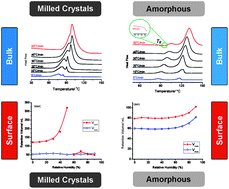This study investigates two apparently similar thermal signatures, shaped as bimodal exotherms, observed when either the crystalline or the amorphous from of the drug are subjected to milling. Crystalline griseofulvin was cryomilled and the (quenched-melt) amorphous form was subjected to either cryomilling or grinding. The thermal and surface properties of the resulting samples were analyzed using differential scanning calorimetry (DSC) and surface energy analysis. After milling, both the crystalline and the amorphous material revealed visually similar bimodal exothermic events when the heating rate was 20 °C min−1. Under different heating rates, the pair of DSC peaks for the bimodal exotherm of each material behaved entirely different from each other. The two peaks of the bimodal event, as well as the glass transition, can be kinetically resolved for the ground amorphous form using standard mode DSC. In contrast, similar analysis was unable to resolve the bimodal exotherm or a glass transition in the case of the cryomilled crystals. Furthermore, cryomilled crystals do not exhibit a glass transition even when analyzed using modulated DSC. Synchrotron sourced X-ray analysis revealed that grinding the amorphous material results in the nucleation and growth of the crystalline form. Milling thus induces disorder in the crystals of griseofulvin but induces order in the amorphous form of the drug. The surface of the two milled systems consistently exhibited different energetics under a wide range of relative humidity conditions. These findings suggest that cryomilling induces both bulk and surface disorder, specifically, a certain level of dislocations on the crystal. In contrast, grinding the amorphous material lowers the activation energy for crystal formation, inducing nuclei formation and growth throughout the amorphous matrix.

You have access to this article
 Please wait while we load your content...
Something went wrong. Try again?
Please wait while we load your content...
Something went wrong. Try again?


 Please wait while we load your content...
Please wait while we load your content...